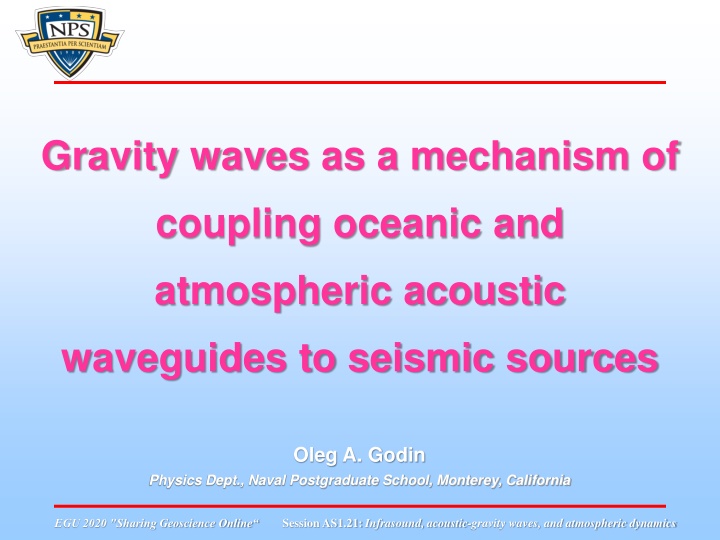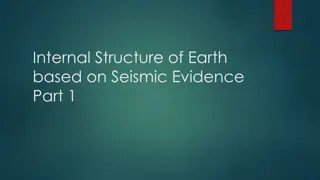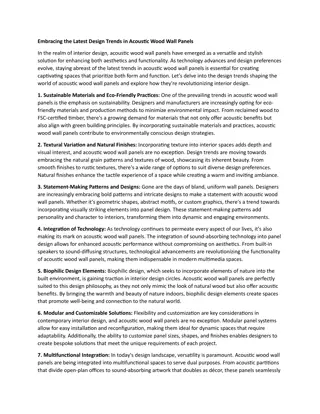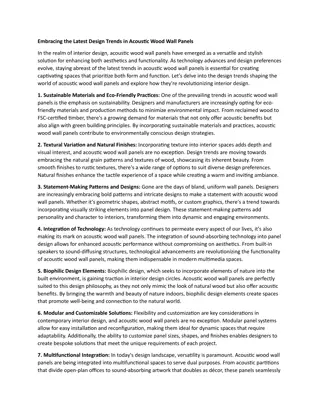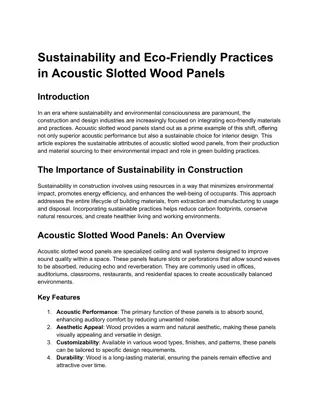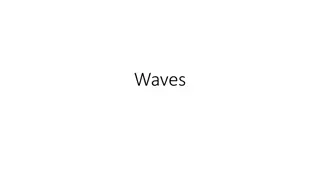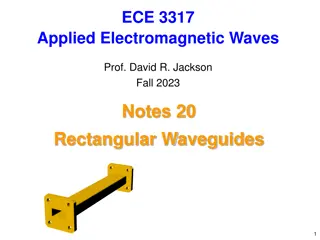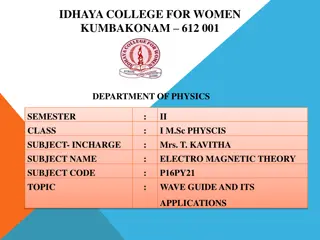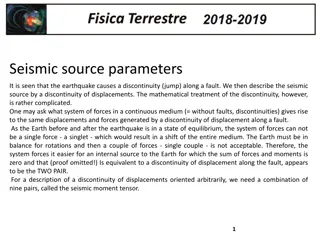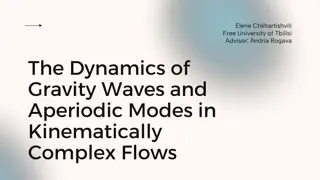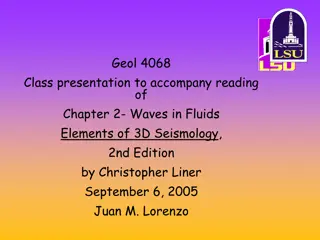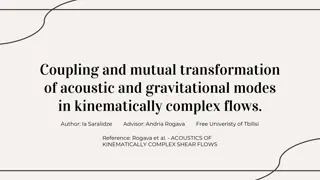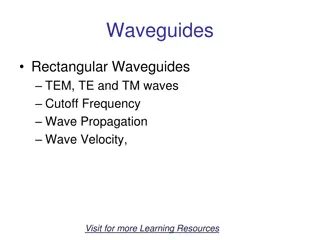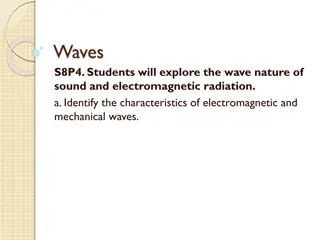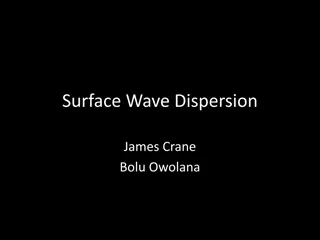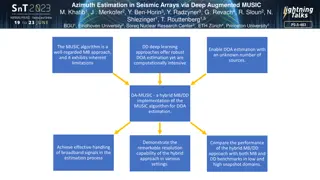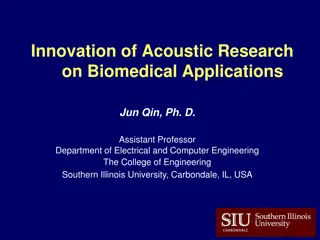Gravity Waves as a Mechanism of Coupling Oceanic and Atmospheric Acoustic Waveguides to Seismic Sources
Direct excitation of acoustic normal modes in horizontally stratified oceanic waveguides is negligible for shallow earthquakes due to velocity disparities. This study evaluates the contribution of scattering by hydrodynamic waves in generating abyssal T-waves. The research explores the role of scattering by gravity waves in exciting infrasonic normal modes by underwater earthquakes and compares model predictions to observations. The paper delves into the complexities of abyssal T-waves, volume scattering by internal gravity waves, and the relative impact of different mechanisms on T-phase generation.
Download Presentation

Please find below an Image/Link to download the presentation.
The content on the website is provided AS IS for your information and personal use only. It may not be sold, licensed, or shared on other websites without obtaining consent from the author.If you encounter any issues during the download, it is possible that the publisher has removed the file from their server.
You are allowed to download the files provided on this website for personal or commercial use, subject to the condition that they are used lawfully. All files are the property of their respective owners.
The content on the website is provided AS IS for your information and personal use only. It may not be sold, licensed, or shared on other websites without obtaining consent from the author.
E N D
Presentation Transcript
Gravity waves as a mechanism of coupling oceanic and atmospheric acoustic waveguides to seismic sources Oleg A. Godin Physics Dept., Naval Postgraduate School, Monterey, California EGU 2020 "Sharing Geoscience Online Session AS1.21: Infrasound, acoustic-gravity waves, and atmospheric dynamics
Abstract Direct excitation of acoustic normal modes in horizontally stratified oceanic waveguides is negligible even for shallow earthquakes because of the disparity between velocities of seismic waves and the sound speed in the water column. T-phases, which propagate at the speed of sound in water, are often reported to originate in the open ocean in the vicinity of the epicenter of an underwater earthquake, even in the absence of prominent bathymetric features or significant seafloor roughness. This paper aims to evaluate the contribution of scattering by hydrodynamic waves into generation of abyssal T-waves. Ocean is modeled as a range-independent waveguide with superimposed volume inhomogeneities due to internal gravity waves and surface roughness due to wind waves and sea swell. Guided acoustic waves are excited by volume and surface scattering of ballistic body waves. The surface scattering mechanism is shown to explain key observational features of abyssal T-waves, including their ubiquity, low-frequency cutoff, presence on seafloor sensors, and weak dependence on the earthquake focus depth. On the other hand, volume scattering due to internal gravity waves proves to be ineffective in coupling the seismic sources to T-waves. The theory is extended to explore a possible role that scattering by gravity waves may play in excitation of infrasonic normal modes of tropospheric and stratospheric waveguides by underwater earthquakes. Model predictions are compared to observations [L. G. Evers, D. Brown, K. D. Heaney, J. D. Assink, P. S. M. Smets, and M. Snellen (2014), Geophys. Res. Lett., 41, 1644 1650] of infrasonic signals generated by the 2004 Macquarie Ridge earthquake. EGU 2020 "Sharing Geoscience Online Session AS1.21: Infrasound, acoustic-gravity waves, and atmospheric dynamics
Outline Motivation and background: o Inefficient coupling between a seismic source and acoustic waveguide o Abyssal T-waves o Intriguing findings from SPECFEM modeling T-phase generation due to sound scattering by wind seas and sea swell: o excitation of acoustic normal modes by surface scattering o relation between the T-wave spectrum and wind speed o dependence of T-wave energy and duration on the earthquake focus depth Volume scattering by internal gravity waves Relative role of commercial shipping and surface gravity waves in T-phase generation Conclusions EGU 2020 "Sharing Geoscience Online Session AS1.21: Infrasound, acoustic-gravity waves, and atmospheric dynamics
What is T-phase? Abyssal T- waves: R . H. Johnson, R. A. Norris, and F. K. Duennebier, Abyssally generated T-phases, in The Crust and Upper Mantle of the Pacific Area, ed. by L. Knopoff, C. L. Drake, and P. J. Hart, Am. Geophys. Union Geophys. Mono. No. 12, 70-78 (1968) R. E. Keenan, L. R. L. Merriam, Arctic abyssal T phases: Coupling seismic energy to the ocean sound channel via under-ice scattering, J. Acoust. Soc. Am. 89, 1128-1133 (1991) Pathways from seismic sources to guided acoustic waves: I. Tolstoy and M . Ewing, The T-phase of shallow focus earthquakes, Bull. Seismol. Soc Am. 40, 25-51 (1950) M. Park, R. I. Odom, and D. J. Soukup, Modal scattering: A key to understanding oceanic T waves, Geophys. Res. Lett. 28, 3401-3404 (2001) E. A. Okal, The generation of T waves by earthquakes, Advances in Geophysics 49, 1-65 (2008) D. R. Bohnenstiehl, Comment on The directionality of acoustic T- phase signals from small magnitude submarine earthquakes [J. Acoust. Soc. Am. 119, 3669 3675 (2006)], J. Acoust. Soc. Am. 121, 1293 1296 (2007) N. R. Chapman and R. Marrett, Reply to Comment on The directionality of acoustic T-phase signals from small magnitude submarine earthquakes [J. Acoust. Soc. Am. 119, 3669 3675 (2006)], J. Acoust. Soc. Am. 121, 1297 1298 (2007) Adapted from: L. Evers, D. Brown, K. Heaney, J. Assink, P. Smets, and M. Snellen, Evanescent wave coupling in a geophysical system: Airborne acoustic signals from the Mw 8.1 Macquarie Ridge earthquake, Geophys. Res. Lett. 41, 1644 1650 (2014) EGU 2020 "Sharing Geoscience Online Session AS1.21: Infrasound, acoustic-gravity waves, and atmospheric dynamics
T-phase generation by earthquakes Mechanisms of T-phase generation: direct excitation by the seismic source bathymetry-related down-slope conversion scattering by rough seafloor ocean surface-related scattering by ships scattering by surface gravity waves volume scattering New insights from application of the spectral finite-element code (SPECFEM): From: A. Bottero, Full-wave numerical simulation of T-waves and of moving acoustic sources, Ph.D. thesis, Universit Aix Marseille (2018) A. Bottero, P. Cristini, and D. Komatitsch, Numerical simulations of T-wave generation and conversion at shores: Influence of slope angles and of the SOFAR channel, JASA 141, 4045 (2017) J. Lecoulant, C. Guennou, L. Guillon, and J. Y. Royer, Three-dimensional modeling of earthquake generated acoustic waves in the ocean in simplified configurations, JASA 146, 2113-2123 (2019) R. Butler, Observations of polarized seismoacoustic T waves at and beneath the seafloor in the abyssal Pacific ocean, JASA 120, 3599-3606 (2006) EGU 2020 "Sharing Geoscience Online Session AS1.21: Infrasound, acoustic-gravity waves, and atmospheric dynamics
Conclusions Sound scattering by wind seas and sea swell appears to be a viable mechanisms of generation of abyssal T-phases. In the frequency band of interest to T-phase studies and under typical open-ocean conditions, sound scattering by surface gravity waves dwarfs that due to shipping. Energy of the surface-generated T-waves is independent of the earthquake focus depth as long as absorption is negligible. The surface scattering mechanism explains key observational features of abyssal T-waves, including their ubiquity, low-frequency cutoff, presence on seafloor sensors, and weak dependence on the earthquake focus depth. Volume scattering due to internal gravity waves is ineffective in coupling the seismic sources to T-waves. Further research is needed to quantify contributions of volume scattering due to smaller-scale sound speed and density inhomogeneities such as those instrumental in seismic oceanography. Sound scattering by a rough sea surface offers also a plausible explanation of the infrasonic counterparts of T-phases observed in the atmosphere. EGU 2020 "Sharing Geoscience Online Session AS1.21: Infrasound, acoustic-gravity waves, and atmospheric dynamics
